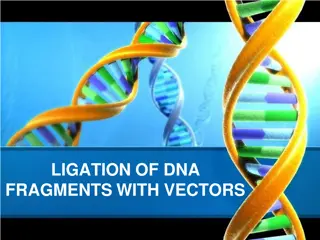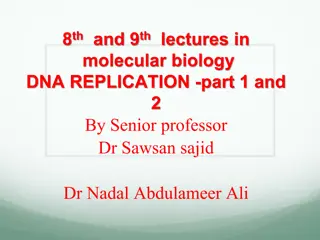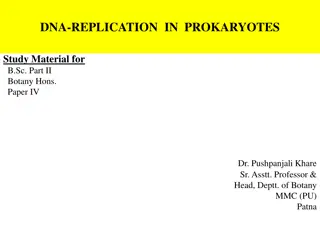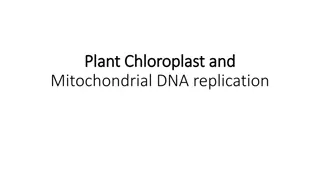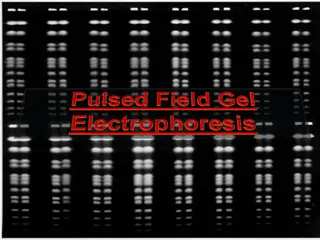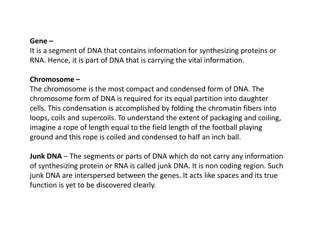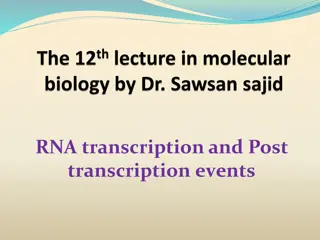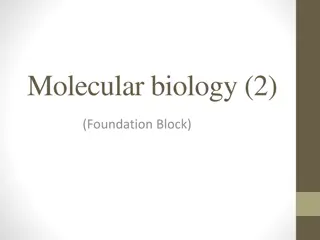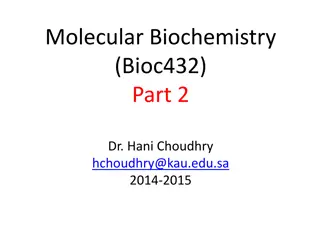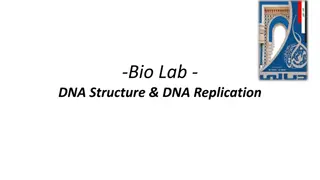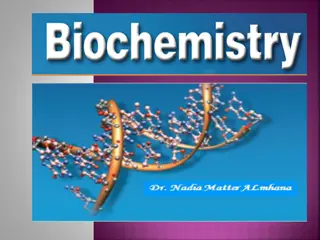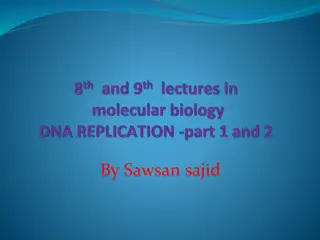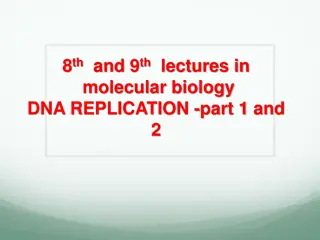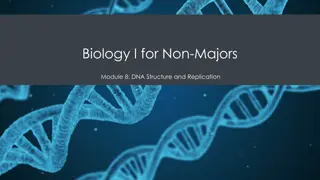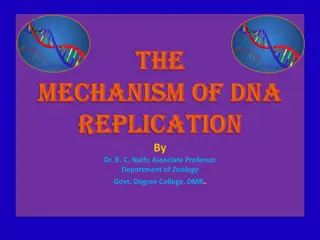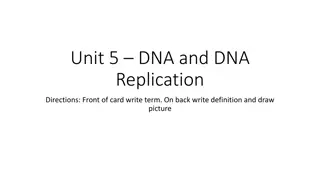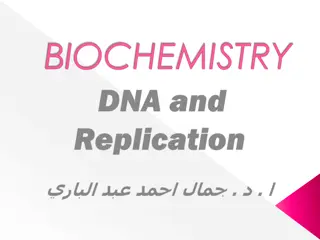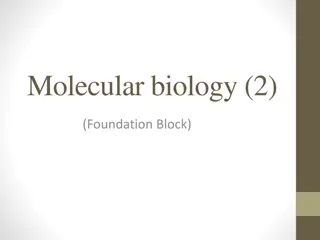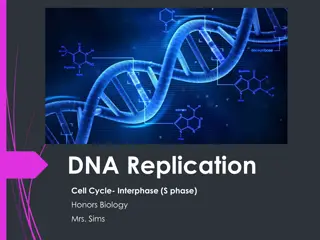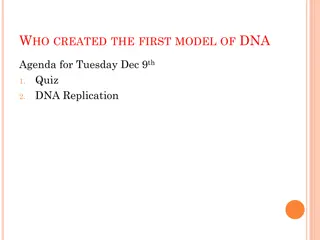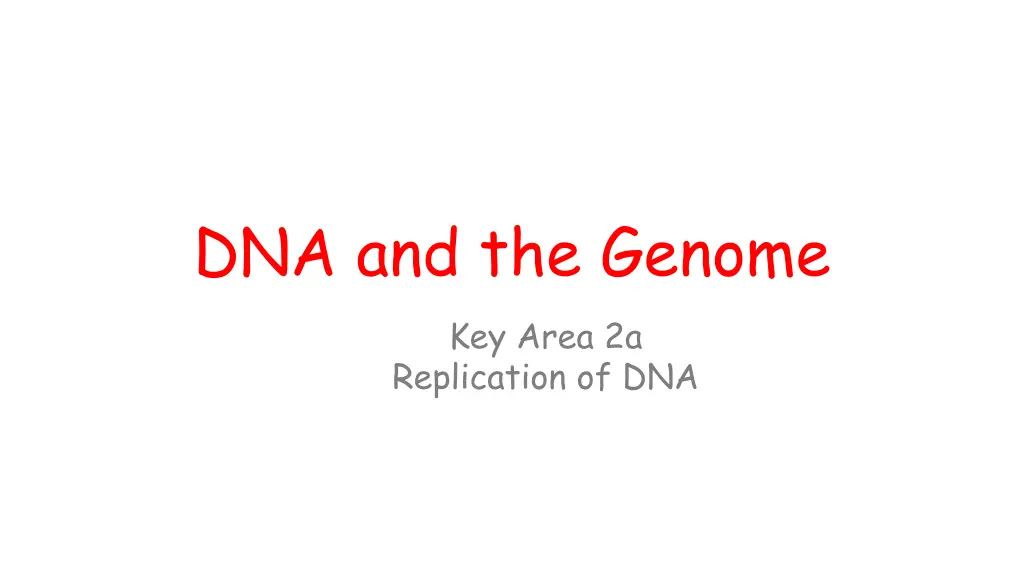
DNA Replication Essentials
Explore the fundamentals of DNA replication including key components like enzymes, stages, and the importance of accurate copying for cell division and inheritance. Understand why cells need to replicate DNA and discover the semi-conservative nature of this essential process.
Download Presentation

Please find below an Image/Link to download the presentation.
The content on the website is provided AS IS for your information and personal use only. It may not be sold, licensed, or shared on other websites without obtaining consent from the author. If you encounter any issues during the download, it is possible that the publisher has removed the file from their server.
You are allowed to download the files provided on this website for personal or commercial use, subject to the condition that they are used lawfully. All files are the property of their respective owners.
The content on the website is provided AS IS for your information and personal use only. It may not be sold, licensed, or shared on other websites without obtaining consent from the author.
E N D
Presentation Transcript
DNA and the Genome Key Area 2a Replication of DNA
Learning Intentions By the end of this topic you should be able to: State the 5 things that must be present for DNA replication Describe the stages in DNA replication Describe what a primer is and explain its role in DNA replication Name 2 enzymes involved in DNA replication Explain the role of each enzyme in DNA replication Describe the direction of replication on each DNA strand Explain why the direction of DNA replication is always in this direction
You should already be able to: Name the molecules in a DNA nucleotide and identify them in a diagram Name the type of bond on the backbone of the DNA molecule Give the names of the 4 DNA bases Describe the base pairing rule for DNA bases Describe the role of hydrogen bonds in the DNA structure State the name of the coiled structure adopted by DNA
Why do cells need to copy their DNA? Prior to cell division, DNA is replicated to ensure that new cells have the same number of chromosomes and to ensure that all cells have the same genes.
Importance of DNA Replication DNA is unique as it can replicate and reproduce itself exactly It is the molecule of inheritance and is passed from one cell to the next during growth and from parent to offspring during reproduction DNA is essential for the continuation of life The process of replication is complex and involves different enzymes including DNA POLYMERASE AND LIGASE
Semi- conservative Replication As the two new molecules formed during replication each contain one strand from the original parent molecule, replication is said to be semi- conservative . Image source: www.physicsforums.com
Nucleic Acids There are two types of nucleic acid you need to know: Deoxyribonucleic acid (DNA) which serves as a cellular database by storing an immense amount of information about all the polypeptides (proteins) a cell can potentially make. Ribonucleic acid (RNA) which occurs in several different forms (messenger RNA, ribosomal RNA, transfer RNA) and is needed to convert DNA information into polypeptide sequences (proteins)
Requirements for DNA Replication For DNA to replicate the following are required: DNA Primers Nucleotides Enzymes ATP to act as the template; provides the code to copy to start replication process and allow attachment of DNA polymerase all 4 bases to produce the new DNA strands DNA polymerase (pair up free nucleotides); Ligase (join Okazaki fragments) to supply the energy for all of the above processes
DNA Replication Enzymes The 2 main enzymes required for DNA replication are: DNA Polymerase: adds DNA nucleotides (using complimentary base pairing) to the 3 end of the new DNA strand that is forming. This means the enzyme can only elongate DNA in a 5 3 direction Ligase: joins fragments of DNA together
Primers The enzyme responsible for adding nucleotides onto a chain is DNA polymerase but to work it can only add them to a pre- existing chain DNA polymerase needs PRIMERS to start replication A primer is a short strand of nucleotides which binds to the 3 end of the template DNA strand allowing polymerase to add nucleotides
3 5 A T STEP 1: DNA is unwound and hydrogen bonds between the bases break to form 2 template strands. Specific primers bind to the 3 end of the template DNA DNA parental strand composed of two complementary strands C G T A G C C G A T 3 5 5 3 5 T A G C A T C G G C T A 3 5 5
T A A G C C T A A T C C G G G C G T T A STEP 2: Free DNA nucleotides start to line up with complementary nucleotides and are held in position by H-bonds T C C A G T A G
3 5 3 5 T A T A G C G C A T A T C G C G G C G C T A T A 5 3 3 5 STEP 3: Sugar-phosphate bonds form. The DNA polymerase catalyses formation of the phosphodiester bond joining nucleotides. Two DNA molecules identical to the parental molecule have been formed.
The leading strand DNA polymerase can only add nucleotides in one direction (5 to 3 ) therefore the leading strand is replicated continuously
The leading strand 1. After the DNA unwinds and the hydrogen bonds break, the DNA unzips. 2. A DNA primer (a short stretch of complementary DNA) attaches to the start of the template DNA. 3. DNA polymerase then attaches free nucleotides to the 3 end of the primer. 4. This continuous process continues until the leading strand is copied.
5 end of DNA strand Leading strand of replicated DNA DNA polymerase enzyme Continuous replication of the leading strand of DNA 3 end of DNA strand Start of complementary strand of replicated DNA Primer
The lagging strand As DNA polymerase can only add onto the 3 end of a primer, the lagging strand is replicated in fragments and these are then joined together
Replication of the lagging strand of DNA The lagging strand Many primers attach along the strand. These are extended by the DNA polymerase. The fragments (Okazaki fragments) are then joined by the enzyme ligase This is a discontinuous process creating the lagging strand. 3 end of DNA strand Primer DNA polymerase Ligase 5 end of DNA strand
Replicating Both Strands The two DNA strands are antiparallel so one strand runs from 3 5 (called the LEADING strand) and the other from 5 3 (called the LAGGING strand DNA polymerase can only synthesize new DNA in the 5 3' direction (directionality). This poses special problems for replicating double-stranded DNA. The leading strand is continuously synthesised but the lagging strand has to be synthesised in fragments (Okazaki Fragments) and then these fragments joined together by the ligase http://www.phschool.com/science/biology_place/biocoach/dnarep/repstrands.html?blah=&step=6
Step 1: DNA unwinds and a short primer bonds to the 3 end of the parental DNA strand by hydrogen bonds between complementary bases Step 2: DNA polymerase adds free nucleotides onto the primer and extends the newly synthesising DNA in a 5 3 direction (bases between new and parent strand held together by hydrogen bonds) New leading strand DNA being synthesised DNA Polymerase Primer
Step 3: a primer binds to the 5 lagging parental DNA strand and polymerase extends new DNA in 5 3 direction forming an Okazaki Fragment (again, hydrogen bonds hold new and parental strands together) New lagging strand DNA being synthesised forming an Okazaki fragment Primer
Step 4: The DNA further unwinds and the leading strand can be continuously synthesised Step 5: A second primer binds to the lagging strand and DNA polymerase extends a second Okazaki fragment (which overwrites the first primer) Step 6: Ligase enzyme will join the 2 Okazaki fragments together and the process is continued Step 7: The 2 new double strands rewind producing the 2 daughter DNA molecules
When copying a long chromosome many replication forks operate simultaneously to speed up the replication process.

